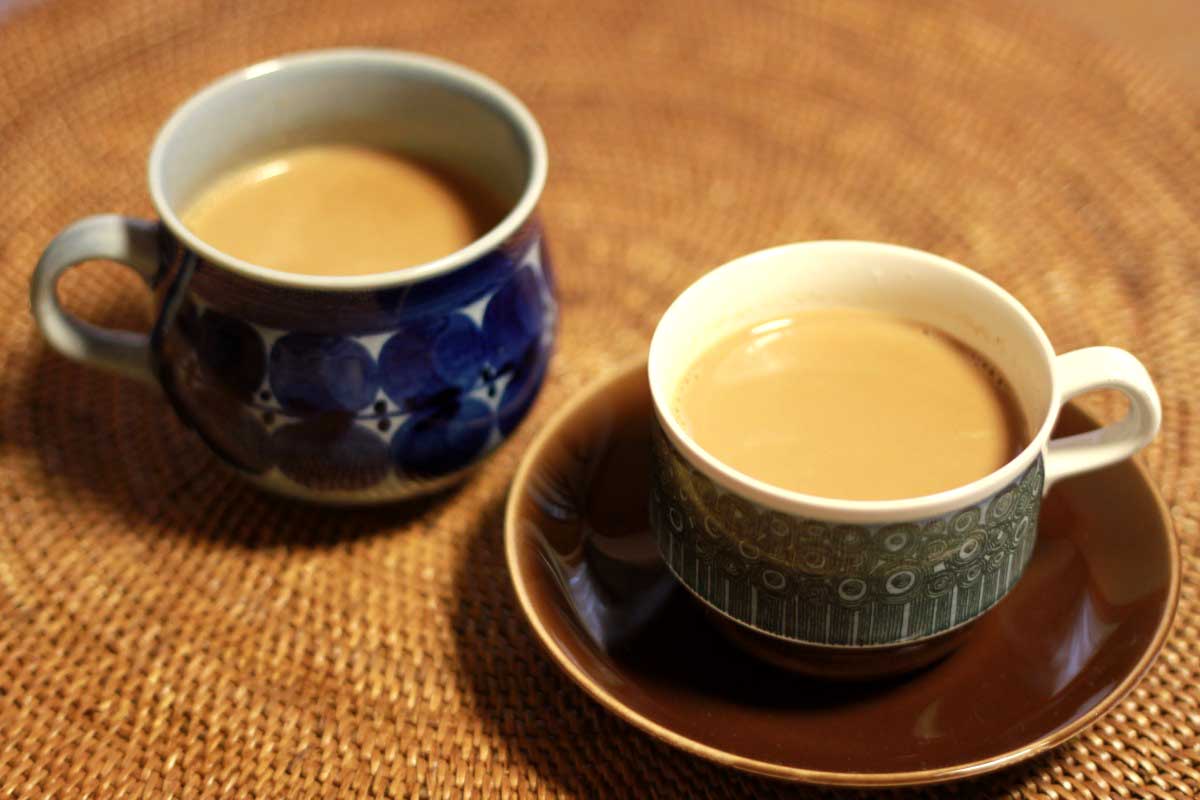Do you love to explore an honest review on the authentic homemade Indian Chai tea recipe? Chai, a beloved beverage, is not just a drink in India; it’s a way of life. You’ll encounter it everywhere, from bustling trains and busy streets to quaint sari shops. This sweet, spicy, and milky elixir has woven itself into the fabric of Indian daily existence.
Chai: More than Just a Flavor
In the United States, “chai” is often synonymous with a tea flavor characterized by notes of cinnamon or cardamom. However, in India, chai is not a flavor but the very essence of tea. In fact, “chai” translates to “tea” in Hindi, so when one says “chai tea,” they are essentially uttering “tea tea.” What might seem like a specialized beverage in the West is, in India, the standard preparation of tea.
Historical Roots of Chai Culture
Chai culture in India has its roots in British colonization. During this period, the British East India Company thrived, and Indian tea, particularly from Assam, became one of its prized commodities. Indians embraced the British-style preparation of tea, which involved black tea, milk, and sugar, and then added their twist with a medley of spices like ginger, cinnamon, and cloves.
Chai Today in India
Today, India is not only a major global tea producer but also one of the world’s largest consumers of this beloved brew. In bustling Indian cities, chaiwallas, vendors who specialize in chai, dot every corner with their colossal steel pots bubbling with aromatic chai. Visiting someone’s home in India almost guarantees you a steaming cup of chai. While regional variations abound, the core ingredients remain consistent: tea, milk, spices, and sweetener. For instance, in Kashmir, green tea sometimes replaces black tea, and almonds find their way into the mix, while in Bhopal, a pinch of salt might surprise your taste buds.
Crafting the Perfect Cup of Chai
Brewing the perfect cup of chai is a harmonious blend of science and artistry, where every ingredient and step is meticulously orchestrated to create a symphony of flavors and aromas. This ancient Indian beverage has transcended borders, captivating tea enthusiasts worldwide with its rich history and diverse variations. In this journey to craft the perfect cup of chai, we delve into the intricacies of each element, from the selection of tea leaves to the delicate balance of spices and the nurturing infusion process. Tea, Coffee, Energy Drinks, Juice, Beverage, Smoothie, and more
Selecting the Finest Tea Leaves
The foundation of any exceptional chai lies in the choice of tea leaves. Opt for robust and full-bodied black tea, such as Assam or Darjeeling, to serve as the canvas for your chai masterpiece. These leaves, plucked from the Camellia sinensis plant, bring depth and character to the brew, providing a sturdy base for the aromatic spices and milk to dance upon.
A Symphony of Spices
The heart and soul of chai are the spices, and here, creativity knows no bounds. Traditional chai spices include cardamom, cinnamon, cloves, ginger, and black peppercorns. Yet, the beauty of chai lies in its adaptability, inviting you to experiment with additional ingredients like star anise, fennel seeds, or even a touch of saffron. Each spice imparts its unique personality, from the warm, citrusy notes of cardamom to the fiery kick of ginger, resulting in a complex flavor profile that evolves with each sip.
Balancing Sweetness and Creaminess
To strike the perfect balance between sweetness and creaminess, sugar and milk play pivotal roles. While the choice of sweetener is a matter of preference, traditionalists often opt for jaggery or unrefined sugar for a deeper, earthy sweetness. Milk, whether dairy or non-dairy, adds a velvety texture and mellows the spices’ intensity. The art lies in finding the ideal proportions that harmonize with your taste buds, a balance as unique as your fingerprint.
The Art of Simmering
Simmering is where the magic of chai truly unfolds. Allow the tea leaves and spices to dance together in a pot of water, gradually building their flavors and releasing their aromas. Patience is key; the longer you simmer, the more intricate the taste. Watch as the chai transforms from a simple mixture to a fragrant elixir, each bubble whispering tales of warmth and comfort.
The Final Act: Straining and Serving
With the simmering complete, the chai is ready for its final act. A gentle strain through a fine sieve or a muslin cloth separates the liquid from the remnants of spices and tea leaves. The resulting liquid, a symphony of colors ranging from amber to deep mahogany, is then poured into a waiting cup, releasing a tantalizing aroma that envelops your senses. Your perfect cup of chai is now complete, a testament to the artistry that is chai-making.
Savoring the Moments
In the world of chai, the process is as enchanting as the final product. Crafting the perfect cup of chai is not merely a culinary endeavor; it is a ritual that beckons you to savor each sip, transporting you to the bustling streets of India, where chaiwallas skillfully brew this elixir. As you cradle your cup of chai, let the warmth and complexity of flavors remind you that, in this humble beverage, lies a world of tradition, innovation, and sensory delight, waiting to be explored and shared.
Breaking Down the Components of Chai
The Foundation of Chai: The Tea Base
Chai, the beloved spiced beverage, finds its essence in the very tea it contains. Within the realm of black teas, one variety stands as the undisputed champion for crafting the perfect chai: Assam black tea. It boasts a robust and full-bodied flavor, an ideal canvas upon which the intricate dance of spices will unfold. However, the world of chai embraces creativity, and some passionate enthusiasts take it a step further. In my own home, for instance, my mother masterfully blends two distinct teas—Assam and Darjeeling. This blend isn’t merely about combining leaves; it’s an art form. It achieves a harmonious balance, not just in terms of color but also in body, aroma, and flavor. This meticulous selection of the tea base sets the stage for a chai that’s nothing short of extraordinary.
The Luscious Creaminess: The Milky Richness of Chai
In the alchemy of chai-making, milk plays a role of unparalleled importance. It’s not just any milk, mind you; it’s whole milk that’s the secret ingredient to unlock the full, opulent richness of chai’s myriad spices. This isn’t a place for compromises; in the world of chai, it’s a realm of whole milk or nothing at all. The creamy, unadulterated essence of whole milk intertwines seamlessly with the aromatic spices, creating a velvety canvas upon which flavors intermingle and dance. It’s the creamy embrace that elevates chai from a mere beverage to a luxurious experience, a symphony of taste and texture that lingers on the palate, leaving an indelible mark of warmth and comfort.
Spices Galore
Chai’s charm lies in its aromatic spices. Cardamom takes the lead, closely followed by a mix of cinnamon, ginger, star anise, and cloves. Pepper, coriander, nutmeg, and fennel occasionally make appearances but are less common. Each family has its unique spice blend; this version boasts cinnamon, clove, fennel seed, and ginger, while my mother’s unconventional concoction features cardamom as the sole star. A pro tip from my mom: always start with fresh spices—think cinnamon sticks, whole cloves, and cardamom pods—for the most exquisite chai.
The Sweetening Touch
For sweetness, plain white sugar is the go-to choice in chai-making. Jaggery, unrefined cane sugar with a concentrated sweet flavor, occasionally makes an appearance but can be challenging to find outside India. Chai typically requires a tad more sugar than you might expect; my mother insists on a heaping teaspoon per cup to fully accentuate the spices’ flavors.
Chai and Its Perfect Pairings
Chai and Snacks: A Culinary Journey
Embracing the allure of chai, with its intricate medley of spices, can be a gradual process, but the snacks that accompany it have a remarkable ability to capture the hearts and palates of enthusiasts instantly. These delightful morsels present a harmonious blend of sweet and spicy, often artfully fried to golden perfection, and expertly designed for the joy of dipping and savoring.
Parle-G: The Quintessential Tea Companion
Enter the world of Parle-G, those iconic sweet, rectangular cookies that beckon you to dunk them into your steaming cup of chai. Seek out the package adorned with the charming visage of a child, a symbol of nostalgia for many. Yet, do not fret if Parle-G isn’t at your fingertips; other biscuits or cookies, though different, equally extend the warm invitation to accompany your chai.
Tiny Sandwiches: Petite Wonders of Flavor
Crafted with finesse, tiny sandwiches emerge, typically fashioned from soft white bread. Inside, they house simple yet enticing ingredients like fresh cucumbers, crisp onions, and perhaps a sprinkling of chat masala for that extra kick. If fortune favors you, you might even find one adorned with a subtle drizzle of ketchup, transforming it into a miniature masterpiece. Fun fact: some have a deep-seated affection for ketchup sandwiches, a testament to the delightful simplicity of this treat.

Samosa: The Tempting Triangular Delight
As the warm, savory aromas waft through the air, it’s impossible to resist the allure of the samosa. These deep-fried pastry pockets are culinary treasures, cradling a tantalizing filling of spicy potatoes and peas within their golden embrace. The challenge lies not in indulging in just one, but in summoning the restraint to stop at only a handful.
Pakora: Crispy, Spicy, and Irresistible
Close your eyes and imagine the sheer delight of deep-fried, spicy vegetables that bear a resemblance to the ethereal tempura but are, dare we say, even better. Pakoras, with their tantalizing blend of spices, crunchy exteriors, and tender interiors, elevate the art of snacking to a sublime level.
Murukku: A Symphony of Crunch and Flavor
Enter the world of murukku, those intricate and crunchy fried snacks crafted from a harmonious blend of rice and lentil flour. Each bite of these intricately shaped delights is a revelation, a symphony of textures and flavors that leaves you craving more. The addictive nature of murukku lies not just in its taste but in the craftsmanship that goes into each piece.
The Art of Snack Selection
The choice of accompaniments to your chai experience is an art form in itself, influenced by the time of day and the occasion. The morning sun may coax you toward the simplicity of bread or sandwiches, where the delicate balance of flavors dances on your taste buds. Yet, as the evening descends, the aroma of chai beckons the arrival of biscuits and pakoras, a testament to the transition from day to night. And when guests grace your home, it’s the grand entrance of samosas, an offering of warmth and hospitality, that makes chai a communal celebration. Each snack, like a well-chosen note in a symphony, adds its unique flavor to the melody of the chai experience.
Exploring the Art of Making Chai
When it comes to crafting the perfect cup of chai, there exists a delightful realm of diversity in techniques and opinions. The fundamental process revolves around the harmonious blend of water, tea, milk, sweetener, and a symphony of spices. Yet, the intricacies of chai preparation, like the order in which these ingredients are introduced, the duration of simmering, and the meticulous straining, are subjects of fervent debate among enthusiasts. It’s a tantalizing journey where every step counts.
Meticulous Chai-Making: A Matter of Sequence
Amid this passionate discourse, a distinctive perspective emerges from Sharma, an authority on chai. With unwavering conviction, she declares that the essence of chai unfolds in a specific sequence. According to her wisdom, you mustn’t plunge all the elements into a pot of water and wait for them to dance together. No, the secret to extracting the profound flavors of tea and spices lies in patient orchestration. First, the water takes center stage, boiling with promise. Then, as the steam weaves its aromatic story, the spices gracefully join the performance. After a few moments, the tea leaves join the ensemble, their fragrance intertwining with the spices’ crescendo. Finally, the milk makes its grand entrance, adding the finishing touch to this exquisite composition. “The key is patience,” Sharma whispers, a mantra that guides her in crafting chai that transcends ordinary expectations.
Chasing Chai Across Time and Culture
Venturing beyond the realm of personal chai preparation, we find the story of chai’s voyage through time and culture. In the late ’90s, Starbucks embarked on a journey of its own by introducing its interpretation of chai, aptly named “chai tea.” This bold move by the coffee giant sparked a trend that reverberated throughout the industry. Coffee shops worldwide followed suit, embracing the exotic allure of chai, albeit sometimes tempering it with the familiar companionship of vanilla or cocoa. Soon, chai’s captivating essence permeated the world of desserts—chai-infused delicacies emerged, from delectable doughnuts to ethereal cream puffs, and even the elegance of chai-laden macarons. A pinnacle moment in the mainstreaming of chai arrived with the creation of Oprah Chai Tea, a collaboration between the iconic Oprah Winfrey, Starbucks, and Teavana. This blend ventured beyond convention, featuring ingredients such as lemongrass, rooibos, and basil, painting a vivid portrait of chai’s evolving identity.
The Irreplaceable Charm of Homemade Chai
Homemade chai, with its aromatic blend of spices, rich black tea, and creamy milk, exudes an irreplaceable charm that transcends the boundaries of mere beverages. This beloved concoction is a testament to the artistry and warmth of traditional Indian hospitality, where each cup is a masterpiece painted with a palette of flavors. Tea, Coffee, Energy Drinks, Juice, Beverage, Smoothie, and more
The Artistry of Homemade Chai
Creating homemade chai is akin to composing a symphony of tastes and aromas. It begins with fragrant spices like cardamom, cinnamon, cloves, and ginger, each contributing its unique note to the composition. These spices, ground and blended with precision, transform a simple tea base into a fragrant elixir that awakens the senses.
The Ritual of Preparation
The process of making homemade chai is not merely a culinary endeavor; it’s a cherished ritual. It involves the meticulous selection of ingredients, from the quality of tea leaves to the choice of dairy or non-dairy milk. The spices are gently toasted, releasing their essential oils, and then combined with the tea leaves, resulting in a harmonious infusion of flavors.
The Heartwarming Tradition
Homemade chai embodies a centuries-old tradition of hospitality. In Indian households, serving chai to guests is a gesture of warmth and welcome. It’s a ritual that transcends generations, connecting people through the shared experience of sipping a steaming cup of spiced tea. The act of brewing and sharing chai fosters bonds and cultivates a sense of togetherness.
A Symphony of Senses
Homemade chai is not merely a drink; it’s a sensory experience. The first whiff of the brewing spices transports you to a world of nostalgia and comfort. The sip itself is a dance of flavors on your palate, with the spicy notes mingling with the earthy richness of tea and the soothing creaminess of milk. It warms you from within, providing solace on a cold day and comfort during life’s storms.
Versatility and Adaptability
Homemade chai is versatile and adaptable to individual tastes. Some prefer it robust, while others savor it mild and delicate. Sweetness levels vary, and creative twists like masala chai or herbal infusions offer endless possibilities. The art of making chai invites experimentation, making it a personal journey of flavor discovery.
An Offering of Love
Ultimately, homemade chai is an offering of love and care. Whether it’s prepared for oneself as a moment of self-indulgence or shared with friends and family, each cup is a gift from the heart. It symbolizes the thoughtfulness and generosity of the person who brews it, embodying the essence of the human connection through the medium of a cherished beverage.
In conclusion, the irreplaceable charm of homemade chai lies not only in its delectable flavors but also in the cultural and emotional tapestry it weaves. It is a blend of tradition, artistry, and the warmth of human connection, making each cup a delightful journey for the senses and the soul.



